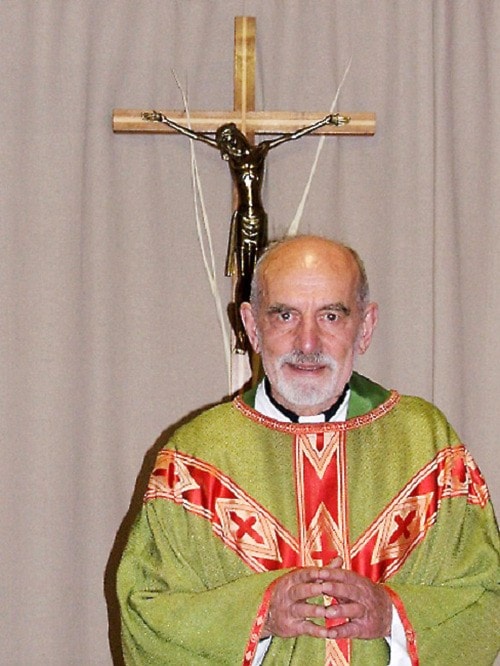Eleanor Deckert
The first Saturday in April will mark Father Emil Sasges’ 56th anniversary as a Roman Catholic priest.
Born Feb. 6, 1931, in Lake Lenore, Saskatchewan, Sasges felt called to the priesthood from a young age.
He was ordained in Vernon, B.C., on April 6, 1957,
Father Sasges has served in Ashcroft, Lytton, Logan Lake, and 100 Mile House, in Kamloops twice, and three times in the North Thompson Valley: 1965 – 76, 1983 – 88, and 2006 – 2012.
Although he retired in November, 2012, at age 82, he is ready to go wherever there is need of a priest.
“As long as I have strength,” he states.
Cache Creek, 100 Mile House, the missions in the Cariboo-Chilcotin and Williams Lake have recently benefited from his efforts with the sacraments and daily mass.
For 56 years he has lived his commitment to daily personal prayer, daily mass (usually multiple times on Sunday), being always available for baptisms, weddings and funerals, hearing confessions, attending the sick, aged and grieving, visiting in prison and welcoming newcomers.
“Serving in small towns has always been a big part of this effort,” Father Sasges explains.
“My first 10 1/2 years serving Valemount as priest will always be special to me,” he said. “I came in July, 1965, with all the eagerness of one beginning a first assignment.”
Beginning with a scattered people who had only experienced infrequent pastoral visits (Father Quigley since 1949), and residents who were themselves transient, there was much to prevent a strong sense of belonging and community.
“I was on the move constantly, the distance and irregular modes of transportation, the seasons and weather causing obstacles and challenges. Rarely did I drive the three hours on the gravel roads between Valemount and Blue River,” he said.
The highway between Avola and Clearwater was under construction. The railroad seemed the best choice because of regularity, efficiency and the fact that many Catholic families lived along the route – the section crews were stationed every eight miles.
Of course, with all the travel, Sasges had to seek meals and shelter in each town.
 In this way he befriended many people, enjoyed home cooking and remembers, “... by being completely dependant on others directly for my food, lodging and even clothing and gas for my car, I knew I was more blessed materially than when I had been able to take a regular salary.”
In this way he befriended many people, enjoyed home cooking and remembers, “... by being completely dependant on others directly for my food, lodging and even clothing and gas for my car, I knew I was more blessed materially than when I had been able to take a regular salary.”
Because Father Sasges was the first resident priest in the area, he had no suitable place to live.
“My first abode in Valemount was an eight by 10 foot shack, which Mrs. Jean Osadchuk kindly offered,” Sasges recalled. “It was beside the laundromat, which had a toilet and shower. When cold weather closed in, Floyd and Tony Larsen gave me a room in the basement, divided from Lyle’s room by a world map tacked up on the studding.”
Other early family names from the mid-’60s and ‘70s included: Labbe, Alain, Rondeaus, Rose, Clark, Hert, Tzkachuks, Poolis, Masciarellis, Nehring, Lebrun, Cummings, and Donnelly.
Father Sasges described how people moved through while employed by Canadian National Railroad, in the logging camps, on construction of the highway, in the sawmills, and on the pipeline construction.
Many were immigrant families who had not yet settled permanently. Others were moving back and forth from ranches in Alberta.
“I found myself a pioneer in that even where to meet for mass was not fixed. Our first masses were in an empty unit of the pipeline duplexes,” he said.
Homes, vacant school houses, the kitchen of the old community hall and other make-shift spaces were transformed by the people who gathered to pray, sing and receive the Lord’s Supper.
Three factors brought about great changes at this time:
First, by the fall of 1967, the Valemount Church and residence, built with donated materials and volunteer labour from the wider community under Sasges’ design, was ready to be used.
Second, the opening of the highway meant even more movement among the parishioners and much more convenient, although less adventuresome, transportation for the priest.
Third, the strength of the ecumenical movement, with a fellowship among Father Emil Sasges (Catholic), Rev. Jim Cruikshank (Anglican) and the United Church pastors, inspired the nurturing of the faith of all regardless of denomination.
And yet, these obvious “improvements” made changes that could be seen as a loss, too. Now Sasges lived alone, no longer interacting with the families for days at a time.”
“Around age 26, when I was newly ordained, I spent free time working with home-built plane enthusiasts in Kamloops,” he said.
– For more about Father Sasges' adventures with his airplane, see the next Valley Voices column in the April 4 issue of the Times.
